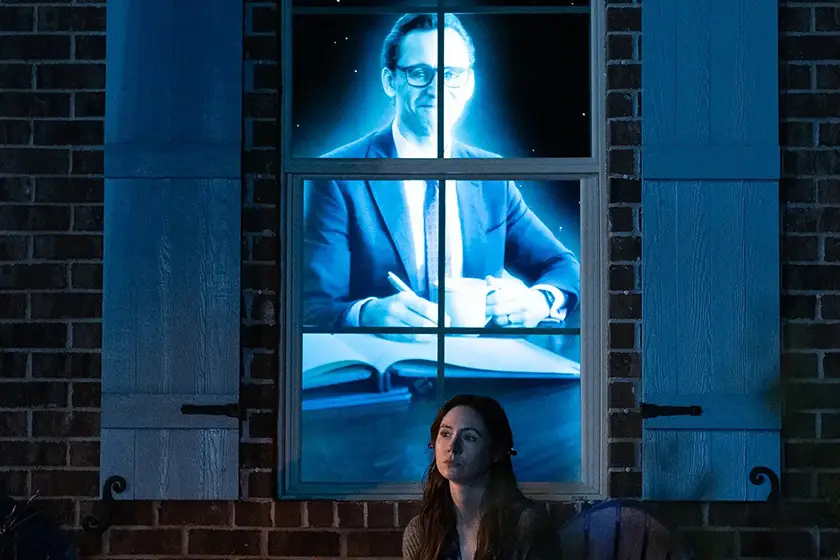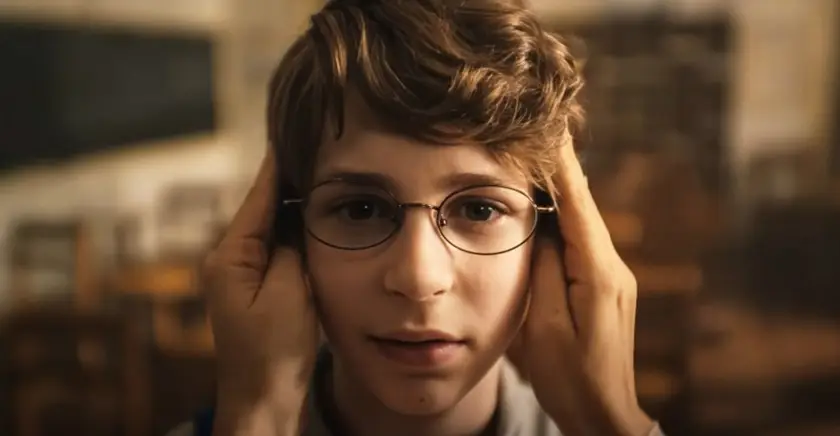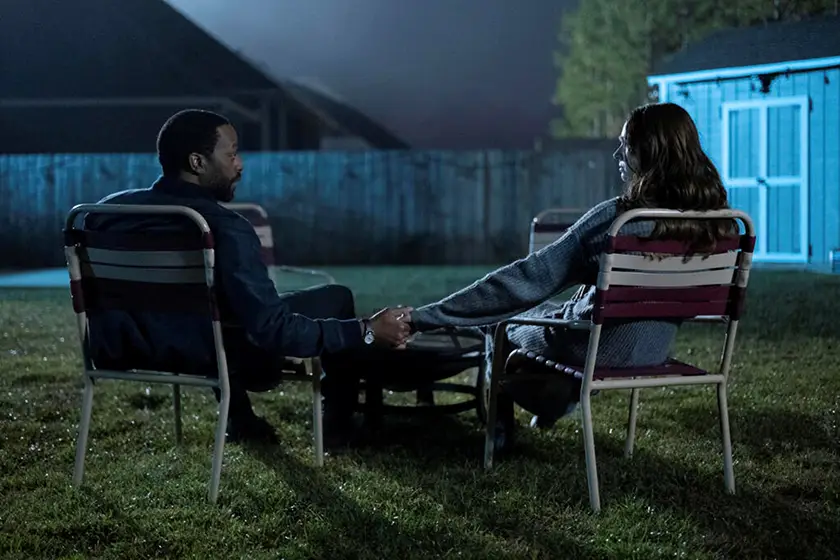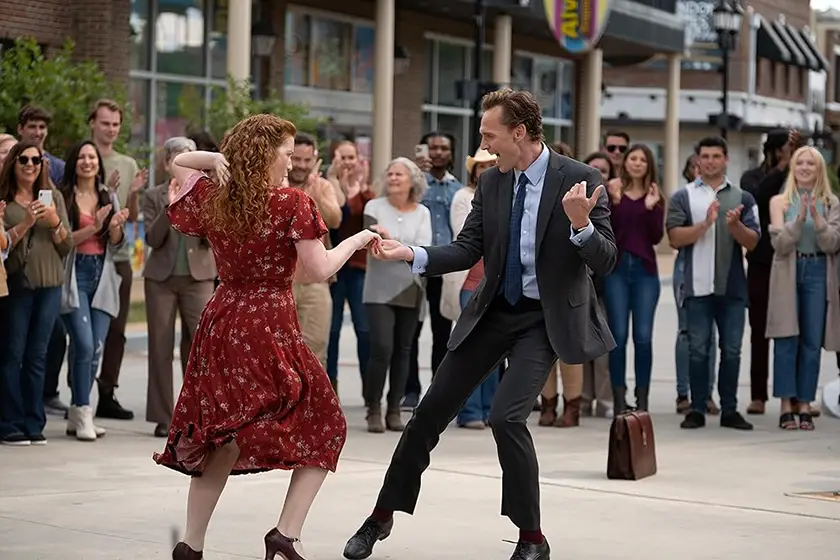The Life of Chuck bends genres and minds to explore the very meaning of life itself. To understand that meaning, let’s get the movie and ending explained!
Forget about just getting the ending explained. Mike Flanagan’s latest effort, The Life of Chuck, is a film where it’s a challenge to explain the basic premise. It looks straightforward at first, as we’re introduced to a near future where human civilization is facing its final days, with the internet, structures, and environment rapidly deteriorating. But the powers that be only seem interested in the retirement of accountant Charles “Chuck” Krantz (Tom Hiddleston, of Loki) after 39 years of work. As the film goes on, it becomes clear that Chuck is somehow linked to the very nature of this world, and we go back to look at his life at a few different stages.
There’s also a dance sequence on the city streets. And a supernatural mystery. And a coming-of-age story. And it’s all narrated by Nick Offerman. Yeah, The Life of Chuck is a strange, genre-bending film. As it nears its conclusion, I can easily see audiences going, “What’s even the point of this?” The best way to answer that question is, of course, to look at its ending and what it says about the rest of the movie.
So, let’s go through the film, discuss that ending, and get the film explained! Which, naturally, means there will be spoilers throughout.
Act Three and the Ending of the World

No, this section isn’t out of order. The Life of Chuck begins with “Act Three” and works backwards from there. The world is in turmoil, as seen through the eyes of middle school teacher Marty Anderson (Chiwetel Ejiofor, of Doctor Strange). Many conversations take place between Marty and other characters. He explains Carl Sagan’s Cosmic Calendar – a scaling of the universe’s lifespan to a single year – for perspective on how long the world could last. His neighbor professes that waiting for the end is the hardest part of all. A friendly mortician discusses the planet’s changed rotation time as a contributing factor, stating math “can’t lie.”
As this all happens, Marty is bombarded with ads and broadcasts celebrating the retirement of regular accountant Charles “Chuck” Krantz, to a point where that becomes the only piece of media anyone can access. After a while, we finally see Chuck himself, who is apparently dying of an illness as opposed to just retiring. As his final moments come, so too do the universe’s. Marty and his amicable ex-wife (Karen Gillan, of Dual) watch all the stars burn out, and Act Three cuts to black as they meet their ends.
Acts Two and One – What is the Life of Chuck?

In Act Two, Chuck himself comes across a busking drummer on his way to a conference. Despite looking like your typical businessman, Chuck begins dancing along to the beat and getting the crowd cheering. He also spots a few minor characters that were present in Act Three… or different versions of them. Act One then shows Chuck as an 11-year-old (Benjamin Pajak) living with his grandparents Albie and Sara (Mark Hamill and Mia Sara). Sara inspires Chuck’s love of dancing, which he pursues in a middle school club to the delight of his crush Cat (Trinity Bliss, of Avatar: The Way of Water). It all seems unextraordinary… until you notice the callbacks to Act Three.
Marty is a teacher at Chuck’s school. Chuck is seen watching Carl Sagan’s Cosmos episode in which Sagan explains the Cosmic Calendar. Albie gets Chuck to appreciate math over dancing using examples like their knowledge of the Earth’s rotation, stating that math “can’t lie.” The mortician character reappears when Albie dies of a stroke. At this point, it’s obvious that the realm of Chuck’s life and the apocalyptic realm of Act Three are not one and the same, but they’re still connected somehow. It’s not until two specific Act One scenes that everything falls into place.
“I Contain Multitudes” – The Centerpiece of The Life of Chuck

Act Three opens with a student reciting Walt Whitman’s poem “Song of Myself.” In Act One, Chuck’s literary teacher (Kate Siegel, of Midnight Mass) explains said poem to him, honing in on the line, “Do I contradict myself? Very well then, I contradict myself, I am large, I contain multitudes.” The teacher explains her interpretation as meaning that everyone, including Chuck, contains a whole expanding universe of people, buildings, and ideas in their own heads, creating the bright, “wonderful” essence of who they are and who they’ll continue to be.
The poem resurfaces in the film’s final scene. After Albie dies, a teenaged Chuck (Jacob Tremblay, of Luca) is given the key to his house’s cupola, which Albie claimed was haunted. (Also, the staircase and door leading into the cupola are seen in Marty’s house in Act Three.) Inside, he sees his grown-up self on his deathbed, recognizing that he is fated to die that way and must now – in the final Act Three callback – wait for the end. Nonetheless, Chuck falls back on Whitman’s work, affirming to himself that he contains multitudes and will therefore not let the vision reshape his view of his life.
The Life of Chuck Ending Explained

I know that was a lengthy recap, but it’s needed in order to unwrap Act Three, which is technically the ending for this Ending Explained article. Yay, loopholes! To start, when Chuck is told he’s created a large world within himself, you can guess what that world is. The entire realm we see in Act Three is more than just linked to Chuck; it is Chuck. It’s filled with everything he watched, every thought that’s been brought his way, every experience, every contradicting opinion within himself, all personified as the people, settings, and conversations in the Act Three world. Which means when Chuck is rapidly dying, or “retiring,” so too is this world.
As you’d probably imagine, this single revelation opens up a can of worms so big that a fisherman could catch years’ worth of food. Everything from the smallest trinkets in a room to the subtlest acting choices may potentially say something about the person Chuck is. When Marty illustrates humanity’s microscopic size in the universe’s history, that may be Chuck coping with his own small life in the grand scheme of humanity. The school dance club flyer Chuck saw as a kid is posted in one shot, but nowhere else. This could speak to how dancing is no longer a prominent part of his life, but he still remembers it in a corner of his mind (which is confirmed in Act Two).
The collapse of the internet in Act Three cuts people off from one another, maybe representing Chuck’s loss of ability to string thoughts together his mind fades. Even different characters’ mannerisms in the face of impending demise could reflect the different facets of Chuck’s emotions at death’s door. Some of them see morbidly dark humor in it all, some seek enlightenment, and some try to rationalize everything through hard logic. Some even take multiple approaches at once. Does that mean there are multitudes within Chuck’s multitudes? After all, the concept of dying and no longer existing is one of the heaviest, most challenging, most brain-shattering thoughts a human being could possibly process.
Nonetheless, it seems like Chuck is handling death with bittersweet, gentle acceptance, because no prominent character in his world of multitudes is in outright despair. They’re scared and sad, but most of them still find some way to hold their heads up until the very end. This could be because Chuck had already seen his dying self in the cupola and learned to cope with his own mortality far earlier than most people would. Maybe that experience is what brought this plane of reality to life in the first place, in sheer defiance of the notion that his finite life is meaningless.
If a 30,000-word article was feasible, I could probably pick apart what every tiny detail may say about Chuck. And even then, my takes would probably vastly differ from anyone else’s. The exact “nature” of what represents what is so infinitely open that it makes The Life of Chuck an extremely difficult movie to fully unpack, even when it reveals what it’s doing. Upon first viewing, I initially considered Act Three too preachy, with characters musing about everything nonstop in overly whimsical ways. But knowing it all represents the inner machinations of a person’s mind, which usually do contain long, extensive thoughts and internal discussions, these musings feel much more justified.
Why is The Life of Chuck Told in Reverse Order?

There’s still the broader question of why, instead of just showing the life of Chuck in a straightforward manner, the film – and, of course, Stephen King’s original story – took this much more atypical approach. Specifically, why not show Chuck’s childhood first, then his adulthood, and then his mind’s “apocalypse” instead of the other way around?
The simplest, shallowest explanation is that the structure draws viewers in with the mystery of how Chuck is connected to the dying world, so we’re later surprised when the cards are shown. But I believe the film also wants to emphasize what Chuck affirms to himself in the cupola: it’s not the end that matters. It’s the experiences you have getting there. And what could be a more fitting set of experiences than the ones in his youth, which set the foundation for every other thought and experience he has?
Or, because both Chuck’s childhood and his dance with the busker are shown after his death, maybe they’re his dying memories that he cherishes the most? Act Two is the sequence that, as the narrator states, Chuck goes back to as the reason for his life to be, even when his memory fades. Why couldn’t the same apply to his formative years as a kid who experiences loss, happiness, and passion, but who also has so much more of his life yet to come? Above all else, I think the story wants to prioritize the most meaningful parts of Chuck’s life by showing them after its end, not before.
The Main Purpose of The Life of Chuck

So, we’ve got an idea of who Chuck is, what he’s been through, and how that ties into the apocalyptic world we initially see. What are we supposed to take away from all this? For me, The Life of Chuck is a celebration of the core essence of being human, and how every life, even a simplistic and basic one, is large and miraculous in its own way. Not because of any grand, flashy, world-changing experiences you have or some deep legacy you leave behind. Instead, it’s because of small, simple experiences like watching old movies with your family, or having a chance encounter on the street, or even getting to look at people’s lives through numbers as a seemingly boring accountant.
The narration directly addresses that Chuck’s adult life isn’t everything he’d envisioned as a kid, but that he’s made peace and found happiness. He’s married to Cat with a kid of their own, he makes a good living, he’s still a kind, poetic person, and he’s not above cutting loose with a random dance act. Every tiny nuance that plays a part in those little moments is life, and they’re shown as special because they further develop the massive universe that is a single human being.
But you’re still meant to feel the overwhelming heaviness when that life ends, and how hard it is to keep going when you know the end is coming. Other lives may go on around you, but it’s still the end of your world, your reality. Act Three takes that concept literally, treating the death of one person with that global scale and severity, before moving on to emphasize that his life beforehand is what truly matters. I can see some people finding Act Three a bit too grim with how much imagery matches a lot of our own global crises, but I see it as a reminder that, just like us, the world as a whole is fragile, finite, but also a special entity containing multitudes. We are multitudes within multitudes.
In short, everything and everyone exists as an exceptional moving part within something bigger and equally exceptional, in ways no one can truly comprehend. That’s the greatest takeaway The Life of Chuck has to offer, and it illustrates the point in such a strange, lyrical, yet simple way that joyously weaves genres together. It’s part drama, sci-fi, horror, comedy, thriller, and musical. It contradicts itself so much yet amazingly works as one memorable entity. Just like we do.
The Life of Chuck is now available to watch in U.S. theaters and will be released in UK & Irish cinemas on August 22, 2025. Read our list of Mike Flanagan’s Netflix horror series ranked from worst to best!

